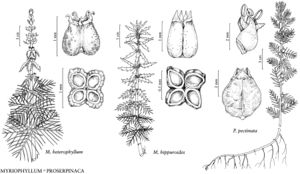Myriophyllum hippuroides
Fl. N. Amer. 1: 530. 1840.
Herbs monoecious, aquatic, sometimes forming dense stands. Stems often branched, to 1.5 m. Turions absent. Leaves usually in whorls of 4 (–6), sometimes subverticillate, heteromorphic; petiole to 3 mm; submersed leaves pectinate, obovate in outline, (12–) 16–30 (–41) × (10) 12–22 (–30) mm, segments 12–24, linear-filiform, longest segment (6–) 9–25 (–36) mm; emersed leaves pectinate to pinnatifid proximally, linear to narrowly oblong or linear-lanceolate distally, (5–) 7–16 (–23) × (0.5–) 1–2.2 (–2.6) mm, often increasing in size distally, segments (5–) 10–16 (–22), 0–2.5 mm, margins serrate to shallowly lobed. Inflorescences to 35 cm; flowers proximally pistillate, medially bisexual, distally staminate; bracteoles cream, ovate to triangular, (0.4–) 0.7–1 × 0.2–0.7 mm, margins irregularly lobed. Staminate flowers: sepals cream, trullate to lanceolate, (0.1–) 0.2–0.4 (–0.5) × 0.1–0.4 (–0.5) mm; petals persistent, cream to pink, elliptic to ovate, 1–1.5 ×0.5–0.8 (–0.9) mm; stamens 4, filaments to 1 mm, anthers 0.5–0.9 × 0.2–0.4 mm. Pistillate flowers: sepals cream, trullate to lanceolate, 0.2–0.4 × 0.1–0.2 mm; petals persistent, cream to pink, elliptic to ovate, 0.7–1.3 × 0.4–0.7 mm; pistils 1.1–1.5 mm, stigmas red to ± purple, to 0.4 mm. Fruits cylindric to subglobose, cruciate to deeply 4-lobed. Mericarps tan to light green to redbrown or purple, cylindric to narrowly ovoid, 1.1–1.5 × 0.4–0.6 mm, transversely elliptic to narrowly ovate, compressed to flattened, abaxial surface bluntly 2-angled, flattened to slightly rounded, papillate to tuberculate, with 2 (or 4) shallow, longitudinal ridges, wings and ribs absent.
Phenology: Flowering and fruiting late Apr–Nov.
Habitat: Oligotrophic to mesotrophic waters, lakes, ponds, pools, riparian sloughs, small streams.
Elevation: 0–1800 m.
Distribution
B.C., Calif., Ill., Oreg., Wash., Mexico, Central America
Discussion
Myriophyllum hippuroides has a disjunct range in North America. It is native to the Pacific Northwest and California, where it can be confused with M. pinnatum and M. heterophyllum (see 12. M. pinnatum). Myriophyllum hippuroides often produces a terrestrial form consisting primarily of emergent leaves. The linear-lanceolate emergent leaves of M. hippuroides are at least three times as long as broad compared to the elliptic to ovate emergent leaves of M. heterophyllum. The most distinctive difference between these species is the morphology of their mericarps. The relatively narrow, transversely elliptic mericarps of M. hippuroides have a sharply 2-angled abaxial surface and are distinctly different from the subglobose and inconspicuously 4-angled mericarps of M. heterophyllum and the widely winged and ribbed mericarps of M. pinnatum.
Selected References
None.
